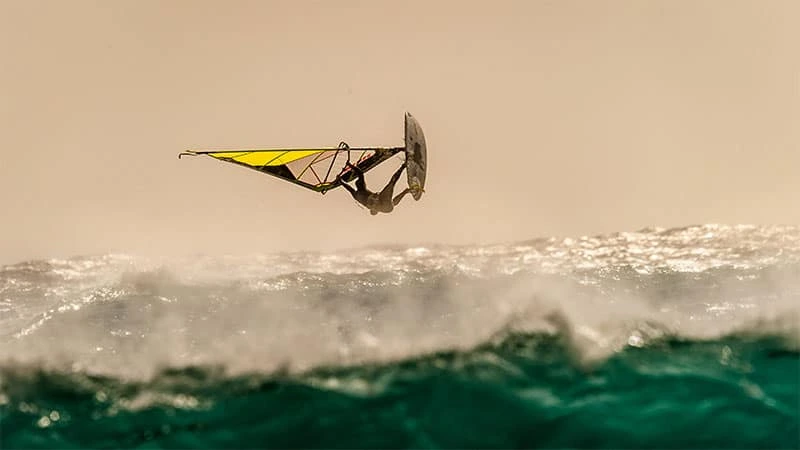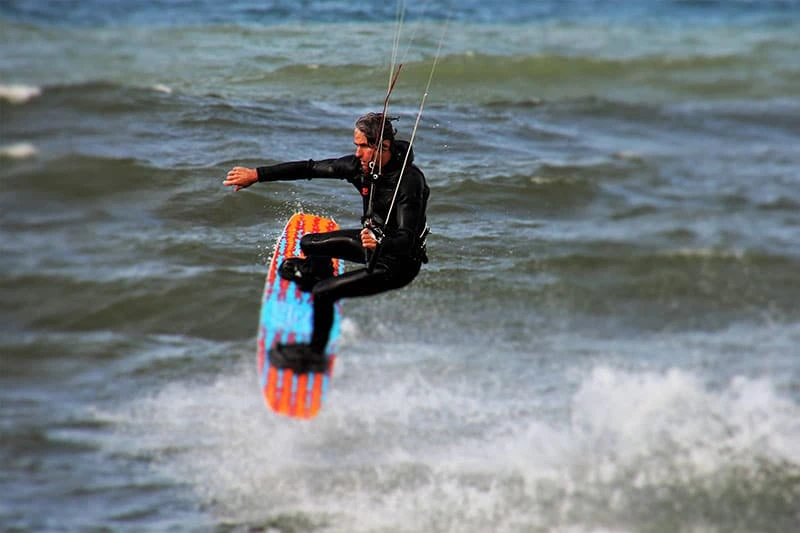
Scroll to Explore
Thursday June 28, 2018
Kitesurfing articles
WINDSURFING vs. KITESURFING
If you are an adventure sports lover, then you must have come across the eternal debate that is common within the community. The debate has to do with finding out which water sport is better: windsurfing or kitesurfing (or kiteboarding). The argument appears to be endless as the lovers and supporters of each of these two extreme sports think and believe that their sport is the better one and therefore the best.
There is no point to prove as regards which of these water sports should be supreme. But for the sake of clarity and for beginners looking to engage in extreme sports, this article will discuss everything that has to do with windsurfing versus kitesurfing.
Windsurfing
Windsurfing – also known as Sailboarding – is an extreme sports activity which involves the use of a surfboard with an attached sail. The windsurfer uses the power of the wind on the sail to glide across the surface of the waves by holding and adjusting the sail accordingly.
Kitesurfing
Kitesurfing – otherwise known as Kiteboarding – is a vibrant water sport that involves the use of a surfboard – attached to your feet – and a kite that works more like a parachute as it is connected to your body by a harness.
The wind can be strong enough to lift you out of the water and several feet into the air, which is one of the reasons why it is classified under extreme sports.
What Is the Major Difference Between These Extreme Sports?
In kitesurfing, you are attached to both the board and the sail or parachute. But with windsurfing, the sail is attached to the board and not to you. This means that if you fall during your voyage, you fall off.
Windsurfing & Kitesurfing Comparison
This is the part where we will be comparing both extreme sports regarding how easy they are to learn and other parameters.
Ease of Learning

The learning curve for both extreme sports are not the same. Windsurfing is far easier to learn and takes only some solid instructions and about two to three hours with flat water and about four to five hours in waves. This is more than enough for anyone to start sailing back and forth on their own.
Kitesurfing is different; first of all, you have to learn how to get to grips with the kite, and this could take a couple of hours on the seashore. Next, you will be required to undergo body dragging through the water before trying to get on the board. This could take up to nine hours, just learning the basics.
Now here is the funny part: after a kitesurfer has spent roughly twenty hours learning the ropes, such a person will be riding at high speed and using techniques that will remain relevant in the next couple of months or years. With kitesurfing, you’ll become a darkslide master in no time!
A windsurfer will have a more gradual, but consistent improvement during that time. This is why it usually seems as if people prefer learning kitesurfing rather than windsurfing.
Transportation
Windsurfing gear appears to be more cumbersome than that of its counterpart as it usually comes with one or two boards – as the case may be – and three sails. The sails weigh a whopping thirty kilogram and can be a hassle if you have to take a flight.
Kitesurfing gear consists of one board and a kite which can be housed in a long bag that looks like the type used for carrying golf clubs. Of the two, kitesurfing gear offers fewer hassles than windsurfing equipment.
Cost of Equipment

The cost of both windsurfing and kitesurfing gear appears to be the same as you can purchase them – brand new – at prices that range from something close to $1,000 up to a few hundred grands. If you prefer buying the used variety, you can get them at prices within a few hundred bucks.
The significant difference, however, lies in the life of each kit. On a general note, windsurf equipment tend to last longer than kitesurf kit before it needs replacement. A kite – in most cases, the lines – will need replacement after about three years of use whereas windsurfing kit can last up to five years or more. This depends mostly on how good you are at taking care of the equipment, e.g. you must not leave the windsurf kit lying around in the hot sun for too long.
Most experts do not advise buying used kitesurfing kit as you may not be able to determine the reliability of the lines. You will need to confirm that there are no leaks at the leading edge and watch out for holes and tears in the material. This shows how fragile the kitesurfing gear is compared to its tougher counterpart.
Evaluating the condition of a sail and board is very easy for a windsurfer.
Independence

Although it is possible to launch and land your kite on your own, experts strongly recommend that you enlist the help of an experienced person who will be at the beach. This person will help you to launch as well as land your kite. To be on the safe side when kitesurfing, therefore, make sure there are people around who will be able to lend a quick hand in case your equipment malfunctions, injury or other unforeseen situation.
You are on your own in most cases when you go windsurfing. However, experienced windsurfers will advise that you get the help of a veteran when starting out because if you don’t, you may end up picking up one or two bad habits. These habits may later prove to be very difficult for you to give up as time goes on.
But on a general note, you are independent whenever you go windsurfing.
Physical Condition

There is no denying that windsurfing is more physically challenging than kitesurfing. It is the ideal physical activity for you if you are looking to build up your physique. This is because your legs will be positioned in a half-squat stance or posture, thus strengthening your buttock muscles and quadriceps. The muscles of your upper-back and your arm are brought to bear when it comes to holding or adjusting the angle of the sail and holding it in position. Ideally, you’d want to get your body ready for windsurfing. Here’s a video workout for endurance and strength which should get you ready for the waves:
Kitesurfing does not call for much physical effort, though you will still need to use your legs as well as your core-stability muscles to control both the speed and the direction of the board.
Safety

When it comes to the area of safety, according to the research, kitesurfing takes the hit as the riskiest physical activity. This is because the severity of the accidents that occur during kitesurfing are significantly higher.
The reason behind the severity or gravity of kitesurfing accidents is that most of the time, the people who engage in this extreme sport have little to no experience. Such people will not know what to do when something unforeseen or out of the ordinary happens when they are airborne.
Additionally, when a kite surfer gets into trouble in mid-flight, the dire consequences can affect anyone who is within the 200—meter range and downwind of them.
Windsurfers, on the other hand, can only affect any person who is about 5 meters downwind. Fewer accidents happen to windsurfers, and although you may come across or hear about windsurfers having sprained ankles, dislocated shoulders, cracked ribs, and broken legs, they are few and far between.
Rescuing a windsurfer after an accident is also a challenge since it mostly occurs on the water. This is why if you happen to take a bad tumble while windsurfing, you should try your best to get on top of the board to conserve your energy. This action will also make you more noticeable or visible to anyone who can raise the alarm or help you. Eventually grab yourself an emergency whistle since it might come in pretty handy if you get yourself in trouble when riding the waves.
Conclusion
Both extreme sports are accessible, sustainable, and also exciting. So, one cannot say one water sport is better than the other. But whichever one you choose to go for, make sure you get adequately trained and engage in the sport under the supervision of a professional or specialist.

























































 ?>/assets/images/sample-image.webp)